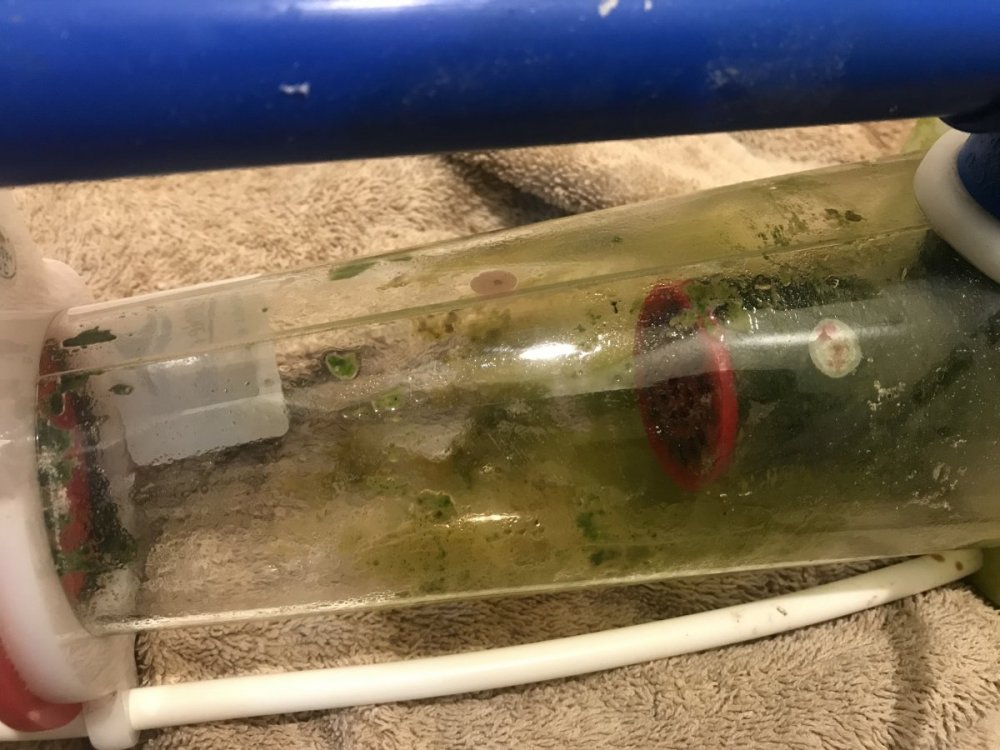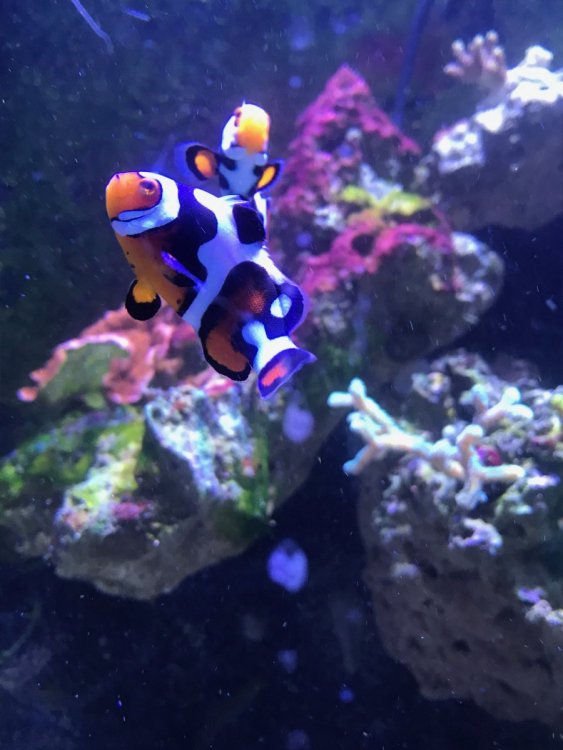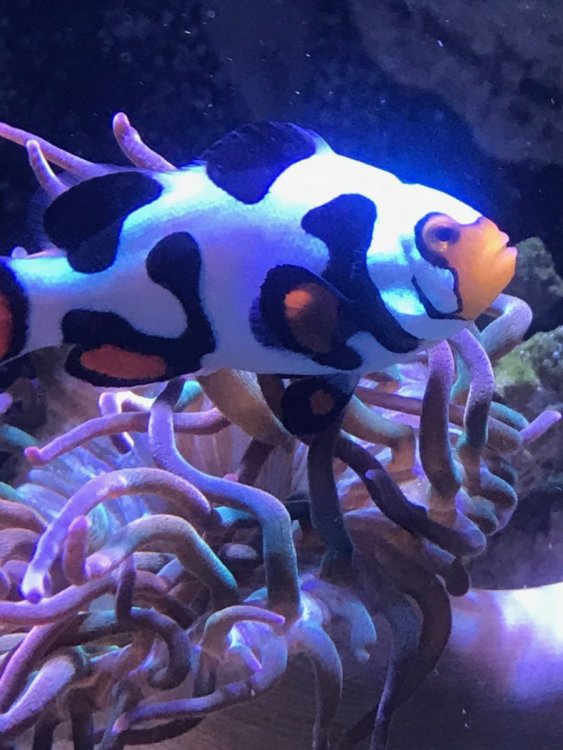
bues0022
BB Participant-
Posts
380 -
Joined
-
Last visited
Content Type
Profiles
Forums
Gallery
Events
Store
Everything posted by bues0022
-
I'm battling a nasty scurge of cyano. Red/purple/green and nasty. Interestingly enough, it's mostly up high where I have relatively good flow (not down in the corners with low light/flow). I've usually had it before under rocks and low flow areas, but this seems to occur almost better in high flow areas. I've upped my water changed (ro/di using reef crystals) - am doing about 20% every week, and decreased feeding, but it still continues. I've never had a phosphate testing kit, as I've always mostly assumed that the cyano uses the phosphate before its available for testing. My cheato is growing really well, but it also has a film of cyano on the top of it (kinda gross). I have absolutely zero hair algae. edits: I have a diamond goby that keeps my shallow sand bed well stirred. I've started skimming quite wet to help pull more out. My BTA just started on a walkabout last week too - since it hadn't moved in the last 4 months, I'm currently attributing that to the same nutrient issue I'm seeing visibly as cyano. Thoughts?
-
Just got in touch with them - they only use polycarbonate now, and they only buy in thin strips instead of sheets. They don’t have much of anything for scraps.
-
Hard to tell about the flow with so much junk in the water ?. I’d get a filter sock running ASAP to catch the suspended stuff though!
-
I have some ideas bouncing around my head of a few little things I want to make from scrap acrylic. Is there any place down near Bristow/Gainesville/manasss, or in the sterling area that sells scrap acrylic? Acrylic shops that sell their excess?
-
Life happened and I didn't get a chance to repair it last night. I'm hoping for tonight - my tank isn't happy without the skimmer.
-
I'm going to be double checking for goop in the crack. I don't think there is, because it wasn't leaking before I took it out of my sump to clean it. After I cleaned it, then it sprung a leak. Also, while gluing it, I plan on using a scraper to force glue down into the crack instead of relying of natural wicking/gravity to have the glue penetrate. It reminds me of a story about my uncle - back when he was in his late teens he bought a used/cheap Volkswagen Beetle. He thought it'd be a good idea to give it a good cleaning with a pressure washer. Not only did the back quarter panel basically fall off (previous guy "fixed" a dent with plaster of paris instead of Bondo), but after cleaning all the grease from the engine compartment - it never ran again. The gaskets were shot, and the grime had built up an "external gasket" on everything. "Cleaning" his car ruined it.
-
Fish sure can sleep goofy! One of my clowns likes to sleep in a little cave where the BTA’s foot is - but it floats up the the roof of the cave, belly up, looking all faded and terrible, and doesn’t move or wiggle at all. It sure gave me a start the first time I saw it like that.
-
I have them about 10-12” above the water - mouthed using the radion arms. There are definitely places in my tank where I found 0 PAR. It was in a shadow, but I could see some light in the shadow so I was surprised it was so low. When I pulled it just barely out of the water directly under the lights the values would go up into the 300s, but 1/4” below the water it dropped to half that value. The only way I could get into the 300’s would be to put the power almost all the way up - at values where I’ve killed corals from too much light. Yes, the sensor was pointing up, and multiplied recorded values by 1.32. The meter did seem to be bouncing around a bit (value of 50 would actually see everything from 40-60, so I recorded 50 as an average). Oh, and the ambient light in the room(5000k bulb color), at waist height directly below a 65W equivalent LED bulb in my basement with 7 foot ceilings measured 1.
-
I have the club PAR meter right now, well, for about another 12 hours. I’ve been doing the testing and I’m a bit confused. The PAR readings are a lot lower than I anticipated. I’m running a single radion over a 30 cube tank. I’m using the WWC lighting schedule at 50%, so my overall max intensity is 42%. Previously, I had them as high as 70%. I’ve had to move corals back into shadows and much lower than I thought they would need because they were showing signs of too much light. Growth is going decent right now since I dropped down to 50% from 70%. The max PAR reading I got, about 2” below the water was 150. According to the PAR meter, my blasto is currently thriving at a PAR of 3. So, thoughts? Do corals really need less PAR than I thought? I was expecting something in the 2-300 for max, I’ve seen others report values this high. LED’s seem to have troubles with PAR meters, is the reported 10% error actually much more?
-
Mine usually works well. When it doesn’t, I just power it off/on then it’s fine. Must be a Microsoft product....
-
I should have clarified a bit with pushing Emory cloth aside. I’m familiar with it - I even have some in the garage. The Emory cloth I have and have used is a good bit thicker than just regular sandpaper. All that is splitting hairs - I agree with the idea to rough up the crack edge and I’ll see which product actually proves most effective. I got a clairifiaction email email this morning from Bubble Magus (again I’m surprised at their continued support and customer service a) on a product well outside the warranty, and b) on a Sunday morning!). He told me the wrong product. He meant 16, not 28. 16 is about $6 on amazon - prime gets it here on Tuesday. I’ll let you guys know how the fix goes.
-
The crack is too thin to get empty cloth inside. I let’s not completely split top to bottom - only the middle few inches. I emailed Bubble Magus last night (couldn’t believe they responded at 10 pm on a Saturday!) it’s out of warranty, but they suggested to either have them fix it for me, or use Weldon 28. That looks more like an epoxy than a solvent glue, and it’s expensive $60 - that’s half the price of this little skimmer! 16 is only $6 or so for the small tube. I wish I still had a lab like my last job - we had every flavor of UV cure adhesive imaginable to glue anything. 5 minutes and I’d be all set ? I’m thinking that I may see if I can try to clean the crack with some sandpaper, try to force some Weldon 16 into the crack and band clamp it. Sound like a decent idea? I suppose if it doesn’t work I could take them up on fixing it for me...
-
The gap is pretty thin - I’m not sure if 16 would penetrate the crack much. What’s the number of the thin stuff? Is it 4 or 3? It’s been years since I’ve used weld-on so I forget the viscosities of them and how it’ll flow or not flow into that crack
-
I thought I was doing good things with maintenance tonight. Water change, trim cheato, clean entire skimmer (not just the cup). I even used a power head and filter sock to clean settled gunk in my sump (wife was out - so I had time to play). My skimmer has sprung a leak. The seam of the body split apparently while I was cleaning it. I don’t know how as I didn’t drop it or manhandle it, but alas it doesn’t hold water. What’s the best method to fix this? I’m thinking the thin Weldon might go in the crack nicely? I don’t have any though. I have silicone, and could goop it on the outside. It’s ugly and may not last either. Thoughts?
-
-
Ask any one of our politicians - it seems to happen frequently to that crowd
-
^ rehab expert there. I also take the "let it grow over old skeleton" approach typically.
-
Copepod & Amphipod Cultivation, Rotifers??
bues0022 replied to realypk's topic in General Discussion
I've been reading about people having success with mandrins by gulturing and feeding white worms and grindal worms. It won't make use of your phyto, but seems to be a good food source. -
ScooterTDI's 12g Long Peninsula
bues0022 replied to ScooterTDI's topic in Dedicated Tank (Build) Forum
Are you still culturing grindal worms? I've been interested in culture some worms for my tank as well. -
live worm feeding - which ones, how to propagate?
bues0022 replied to bues0022's topic in General Discussion
I actually found articles on both written by him. The blackworm one from RC I linked above, and his white worm one here: https://www.thereeftank.com/forums/f6/wash-your-white-worms-277482.html I'm interested to hear from him, after doing both, which one is better to start with. I'm thinking white worms because they don't involve running water (consideration for the space I have at the moment), and they seem to propagate quite easily. Some noted on the blackworm thread that the cleaner shrimp didn't go for the blackworms. I wonder if that's also true for white worms. It would be awesome to feed some corals with food that the shrimp won't steal. Not sure if the corals will catch the wriggling buggers though. -
I ran across an old Reefcentral post which our own Paul B contributed heavy on - from way back in 2010 ( http://www.reefcentral.com/forums/showthread.php?t=1907090&highlight=blackworm ). I'm hoping he sees this thread and can chime in - both for the extraordinary depth of knowledge, but also the not to subtle wit and sarcasm that tends to drip from every post - it cracks me up. I've been considering getting into feeding something other than pellets/flake/homebrew frozen foods. Live worms seemed interesting. The thread I linked above was discussing black worms, but white worms are also fed in reef tanks. Which one and why? Is one easier (and less smelly) to propagate? Having a super nutritious, renewable food source seems like a no brainer. As an aside (for Paul), on page 4, you were discussing the benefits of fish oil fed to fish, and the other guy seemed to be giving you a hard time - I seem to recall seeing a BRS/WWC youtube a few weeks back (it was likely already old news by the time I saw it), where WWC believes in feeding their tank a "fish mash" as they think even the corals do better with the fats/oils their food provides the water column. I've been feeding my fish lately a mash of squid and bunker (a super oily fish that I had left over from baiting crab traps this summer). I put them in a blender and let 'er go. I know much of the oil get skimmed out, but my fish go nuts for the oily fatty food, corals eat like crazy, and while it could have been a better mix, I'm quite happy that I chose to chuck the whole fish in the blender (skin, scales, guts, and all) instead of only the meat fillets.
-
The Case of the Missing Wheeler's Goby
bues0022 replied to MeganTheProfishional's topic in General Discussion
When I brought my Hector's goby home, it was about 3 days until I saw the guy again. I only have a 30 gallon cube, so also not much rock. At that time I didn't have any CUC, so I figured I'd see some evidence (body or nutrient spike) of death. I just kept feeding like he was in there and hoped for the best. I don't know about the goby and shrimp pair you specifically have, but my bet is they are hanging out in the sand someplace. BTW - I'm always hesitant to lift rocks to search for inhabitants for fear of crushing them when I put the rock back down unknowningly on top of them. -
I'm not so sure you've fixed the entirety of your problem. As Tom said, you're "missing" enough salt for 13 gallons of water. You skim 1/2 gallon every 2 days. In 2 weeks, therefore, you've skimmed 3.5 gallons. That's only 1/4 of the missing salt. If the last statement I have you quoted in here represents how/where you think the majority of the missing salt went, then I think there's still another explanation. I've had my tank before where after a water change I would have sworn I had one reading, only to take it a second time and get another. Bubbles on the refractometer will make results goofy - even little ones I've seen skew it. I always take at least 2 different readings before I start trusting it.
-
My Coral Rehabilitation Project
bues0022 replied to ReefdUp's topic in Conservation & Sustainability
What's your secret? You have some very impressive results - corals that I would have almost guaranteed were toast you have brought back.




